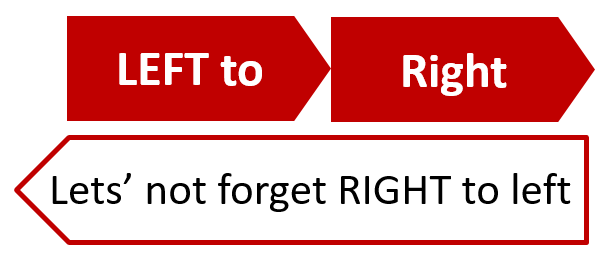Consultants, by the nature of their project-based work, are process oriented. Projects have a start-middle-end. That’s part of the luxury, tempo, and fun of the work. At the beginning, proposals are signed and kick-off meetings held. At the end, recommendations are pre-wired, and final presentations scheduled.

Process: LEFT to right
In the US, and most places, you read PowerPoint slides from the LEFT to the right. In most proposals, kick-off documents, and anything where you are outlining a process, you sees something that looks like this.

So, it only make sense to think from the LEFT (beginning) to the RIGHT (end). This has so many benefits:
- Clearly shows the client (and the team) what the approach is
- Provides a weekly/monthly roadmap of where the project is headed
- Breaks the work into manageable pieces; sets the tempo of the project
- Lends credibility to the consultant’s approach; “yes, there is a plan”
- Checks the speedometer (are we moving fast enough?)
- Checks the odometer (how far have we gone? how much is left?)
Purpose: RIGHT to left
Was recently speaking at the UBSLC to more than 25 student leaders, and someone from the audience (Go Bears) asked about thinking with the end in mind. BOOM. Thinking RIGHT to left. What is it that we’re trying to do? What are we trying to say? What does success look like? What do you want your customers to feel – after buying the product, experiencing the service?

LEFT to right: Process
Often, clients need help with their processes. Sometimes, they are trying to do too many things. Straddling initiatives. Sometimes, they need some double-shot of ambition, adrenaline, and action from the consultants. Sometimes, it’s a form of corporate marriage counseling among business units, departments, or people. Sometimes, the process-centric approach helps. Step 1, 2, 3, keep your eyes forward, 4, 5, 6. Good job.
RIGHT to left: Purpose
Other times, it’s about leadership. Other times, it’s about thinking (slowly and) deeply about what the goal is and WHY it’s important. Other times, it’s about motivating the heart, not just the head. All my strategy students read this interview of A.G. Lafley (ex-CEO of P&G) by Korn Ferry here. Worth your time. He puts it simply, “The Purpose of Strategy is to Win.”
Lafley . . . Humble, not really. Successful, yes definitely. His point is still fair. Know what you are trying to do. Figure out where you want to compete and how you can differentiate yourself and win. Commit. Lead. Don’t get lulled into the siren song of “keeping my options open”, which is just high-school code-words for indecision.
Purpose = no change, Process = always changes
Andy Stanley is a pastor based in Atlanta; founder of a mega-church. He also has a great podcast on leadership here. One thing I remember him saying [paraphrase] is that the purpose of an organization / service / company should not change. That’s the rock it’s built on. That’s the reason it exists. However, the process should constantly be changing to adapt to the environment, and in services of the purpose. Use the process to help you get to the purpose.

Great way of looking at things by examining and understanding the end in mind. Another way I found was asking clients ‘What does good look like?’ This helps define the ‘to be’ state by not asking for gold plated answer nor a half baked idea. It also needs to tie back to the value proposition that it helps solve customer pains and constraints to achieving gains.
110%. This is also key for so many reasons: 1) consultants should listen 2) words matter – so what words are they using to describe this 3) what happens when they – themselves – cannot describe it 4) great, safe place to gently pushback on an unformed, or immature view of nirvana. Nirvana is prohibitively expensive. You can’t be 5 out of 5 on the maturity model for everything.
Great article. I have forwarded to my team to read!
Hope you are keeping well
Super winning.
Funny, similarly and tactically, I often tell people not to think of working through process using SIPOC, but rather O-COPIS, where O=desired outcome. Helps keep people focused on the purpose.
Dude. I like that alot.
John Braddock wrote about this in his books recounting his experience in the CIA. He said they were trained to “imagine forward and reason backward”. Plus just a little bit of game theory mixed in.
Nice, yes – it reminds me a lot of the concept of commander’s intent. Gotta know what success looks like. . .